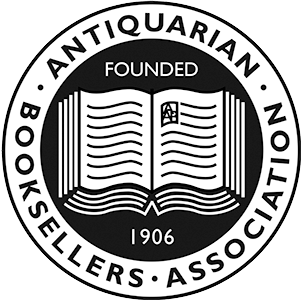A collection of 50 albumen prints, from the British Museum Series, numerous manuscript captions, slight age-related toning, photographs mounted to album, occasional light marginal foxing not affecting image, original maroon cloth with quarter morocco spine, retaining studs, title gilt to spine, slightly rubbed, folio, [London: W.A. Mansell, c.1897]
The 50 photographs of antiquities in the British Museum, covering Greek, Roman and Etruscan Statues and Vases, including 24 of the Parthenon Frieze. Many of the images are accompanied by manuscript captions. Other photographs include:
Horse of Selene, Ilissos, "Colossal Lion", [The Piranesi Vase] "Marble Vase (found in the Villa of Hadrian at Tivoli)", "Mercury", "Venus de Medici", "The "Townley" Venus", "Venus Entering Bath", "Apollo as a Player of the Lyre, from Cyrene", "Hercules", Hercules found in Hadrian's villa at Tivoli, Drum of Sculptured Column from Temple of Diana [Artemision], Ephesus, "Casts from Balustrade of Temple of Wingless Victory - Athens -", Etruscan Sepulchral Monument in terracotta, "Thalia"
T. Aurelius Fulvius Antonius Pius, Aurelius Antoni, Satyr, Apollo, Demeter [Ceres] and Sepulchral Rites at the Tomb of a Hero.
The Elgin Marbles are a collection of statues and architectural decoration acquired by the Earl of Elgin during his time as Ambassador to the Ottoman Empire. He successfully petitioned the authorities to be able to measure, draw and remove figures in various ruins. The most extensive work was on the Parthenon or Temple of Athena, but he also received permission to remove sculptural and architectural elements from a number of other ruins including the Acropolis and the Temple of Nike Athena.
The most famous of the Elgin Marbles are the Parthenon Sculptures, a collection of different types of marble architectural decoration on the Parthenon. The Parthenon Frieze, 75 metres in length, depicts various scenes including the battle between the Lapitas and the Centaurs at the marriage feast of Peirithoos. Elgin originally intended on using the Frieze as decoration in his private home, but due to the collapse of his marriage he sold them to the British Museum. There have been debates over the legitimacy of Elgin's excavation. After an investigation from a Parliamentary Select Committee in 1816, Elgin's actions were found to be entirely legal. Since 1983 Greece has formally requested the British Museum to return all the Parthenon Sculptures in the Museum's collection, the British Museum states there are no current discussions with the Greek Government on this issue.
Roger Fenton is one of the most celebrated figures in the history of photography. He was a creative and highly influential photographer in the mediums "golden age" of the 1850s. In his role as the British Museum's first official photographer, Fenton demonstrated his sure sense as a 'photo artist'. He was initially engaged to photograph cuneiform tablets, but that soon developed into taking pictures of other antiquities. As early as 1852 Fenton received permission from the Trustees to photograph antiquities within the museum, establishing a small studio inside the museum the following year. He left in 1854 to serve as a photographer in the Crimean War (for which he is most widely known) but he was re-appointed on his return in 1856 until the termination of his contract in July 1859. The Trustees decided that photography was not cost effective and, after they failed to negotiate the South Kensington Museum (now the V&A) as an alternative, Fenton terminated his association with the British Museum.
References: The British Museum, The Metropolitan Museum of Art, Luminous-Lint.


![[50 Photographs of Antiquities, including the Elgin Marbles] British Museum Series (photo 1)](https://d3525k1ryd2155.cloudfront.net/h/126/842/1407842126.0.x.jpg)
![[50 Photographs of Antiquities, including the Elgin Marbles] British Museum Series (photo 2)](https://d3525k1ryd2155.cloudfront.net/h/126/842/1407842126.1.x.jpg)
![[50 Photographs of Antiquities, including the Elgin Marbles] British Museum Series (photo 3)](https://d3525k1ryd2155.cloudfront.net/h/126/842/1407842126.2.x.jpg)
![[50 Photographs of Antiquities, including the Elgin Marbles] British Museum Series (photo 4)](https://d3525k1ryd2155.cloudfront.net/h/126/842/1407842126.3.x.jpg)
![[50 Photographs of Antiquities, including the Elgin Marbles] British Museum Series (photo 5)](https://d3525k1ryd2155.cloudfront.net/h/126/842/1407842126.4.x.jpg)
![[50 Photographs of Antiquities, including the Elgin Marbles] British Museum Series (photo 6)](https://d3525k1ryd2155.cloudfront.net/h/126/842/1407842126.5.x.jpg)




